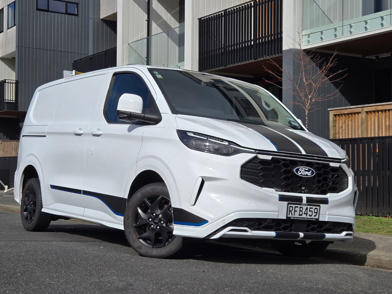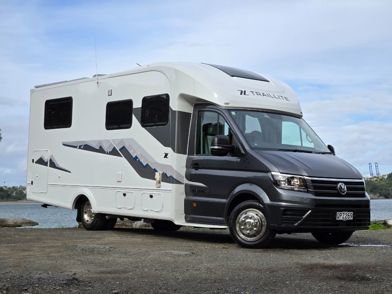What’s this new van all about then?
Scudo is Fiat’s mid-sized van, so it sits right in the mainstream of properly work-focused light commercials. It’s a smaller sibling to the Ducato.

If you’re not familiar, we understand: it’s not well-known in New Zealand, so it might not be the first white box you think of when configuring your SME fleet.
But Scudo is a big deal in Europe, because Fiat Professional (that’s what the brand’s commercial-vehicle division is called) is a big deal in Europe. The “Fiat Professional Scudo” comes in two lengths, two heights, as a van or people mover, and with a dizzying array of powertrain options, including the pure-electric E-Scudo.
Because Scudo is part of the giant Stellantis group, it’s also essentially the same vehicle as the Peugeot Expert/Traveller, Citroen Dispatch/Jumpy/SpaceTourer, Opel Vivaro/Zafira Life and the Iveco Jolly. In a separate deal outside Stellantis-owned brands, it’s also a Toyota ProAce. And… let’s take a breath.

Scudo is kept very simple in NZ, with a single panel-van model in the longer configuration (5331mm compared to 4998mm), powered by a 106kW/370Nm 2.0-litre turbo-diesel engine with an 8-speed automatic. It’s front-drive.
Scudo is not well-known in NZ, so it might not be the first white box you think of when configuring your SME fleet.
That physical size places it at the upper end of the medium-van brigade: it’s longer than a standard-wheelbase Toyota Hiace, Ford Transit Custom or Volkswagen Transporter, for example.

It’s a van, so we’ll need some proper stats. It rides on a long 3275mm wheelbase, with 935mm apertures for the standard twin sliding side doors. The front bulkhead/security grille are standard-fit.
It's pretty slick to drive, which should not surprise because the Scudo and its sister models are based on a Stellantis passenger-car platform.
Load length at the floor is 2862mm, while load width is 1636mm (or 1258mm between the arches). Maximum payload is a generous 1329kg and total load capacity is 6.1 cubic metres. Generally, it’s pretty big for this segment on the inside as well.

Why not reference the larger versions of the Scudo’s rivals, then? Great question, and that brings us to the next bit.
How much is it?
The single Scudo available here is $59,990, which puts it line-ball or below the price of the smallest versions of most van-rivals (unless they’re on extreme special pricing, like the runout VW Transporter 6.1). We’ll talk more about that in a minute.
What’s it like to drive?
Pretty slick actually, which should not surprise because the Scudo and its sister models are based on a Stellantis passenger-car platform.

The turbo-diesel engine is quite refined in a van-context and the 8-speed automatic is quite refined in any context, with smooth shifting and excellent throttle response. It’s actually quite relaxing to drive. For a van.
Although it does roll back an alarming amount from standstill, before the gearbox catches and propels you forward; that's weird for a conventional auto.

The steering is super-light but the Scudo handles with real assurance. Shame about the cruise control, though: it’s just a standard system rather than adaptive, which seems odd in 2025.
There is camera-based safety stuff including Intelligent Speed Assistance, Lane Keeping, Advance Emergency Braking and Driver Attention Alert. No 360-degree parking cameras sadly, but you do get a reversing display that can be switched to a top-down view, and rear distance sensors. On the subject of parking, power-fold side mirrors are a real asset on a van, but Scudo doesn’t have ’em.

The cabin is ultra-simple, made of hard-but-hardy plastics, but Scudo is on point with tech. There are twin 10-inch digital clusters, with the infotainment screen featuring wireless phone projection; no wireless charging though, and the USB ports are of the older A-type.
The main instrument display looks a bit old-hat but it’s actually quite nifty. It’s split into three sections, with the outer two easily configurable via a drag-and-drop function on the infotainment display. This kind of stuff can be quite hard to fathom in modern cars; in Scudo, it’s pleasingly intuitive and we had it sussed in 5 minutes.

Phone projection is nicely integrated, too. For example, when you have navigation running via Android Auto on the infotainment display, notifications for turns pop up on the main instrument display as well.
What’s the pick of the range?
There’s just the one Scudo, like we said. Given the value and heritage of this model, it’d be interesting to see how the shorter (it’s still quite large, really) version at an even lower price would go.
What other vans should I consider?
Couple of things to be aware of, before we continue. First, the world of vans is a barrage of incremental model adjustments depending on customer wants/needs (wheelbases, heights and everything else are made of multitudes), so any attempt to be comprehensive here will result in a lot of words and numbers and present a genuine risk of drowsiness.

Second, we love vans, but the intricacies of the van market are well out of our wheelhouse. We’re van lovers, not van experts (it’s Driven Car Guide, after all). If you’re in the van-world, you’ll know a lot more about this stuff than us.
Bearing all of that in mind, here we go: Scudo’s place in the medium-van segment means it comes up against big names like Toyota Hiace, Ford Transit Custom and Volkswagen Transporter. Let’s not forget Mercedes-Benz Vito, Renault Trafic and especially the Peugeot Expert, which is essentially the same vehicle.
As we said up top there, Fiat NZ’s decision to bring only the longer model in, but keep the price under $60k, means Scudo stacks up pretty well on cost-versus-carrying capacity.
Just taking a snapshot of two of the short-wheelbase van icons, Hiace and Transit Custom, the Kiwi-spec Scudo beats them both on load length and payload, and is only just pipped at the post by Hiace on load volume: 6.1 cubic metres versus 6.2. The standard Hiace ZR is $59,990, the Transit Custom $66,990.
The Fiat Scudo is the same price as the entry version of its paternal twin, the Peugeot Expert, but the French commercial is the shorter (4998mm) version; the longer one is available at extra cost, though.
The Expert does answer back with the option of a pure-electric powertrain for Kiwi customers. It’s a whopping $92,990, though.





